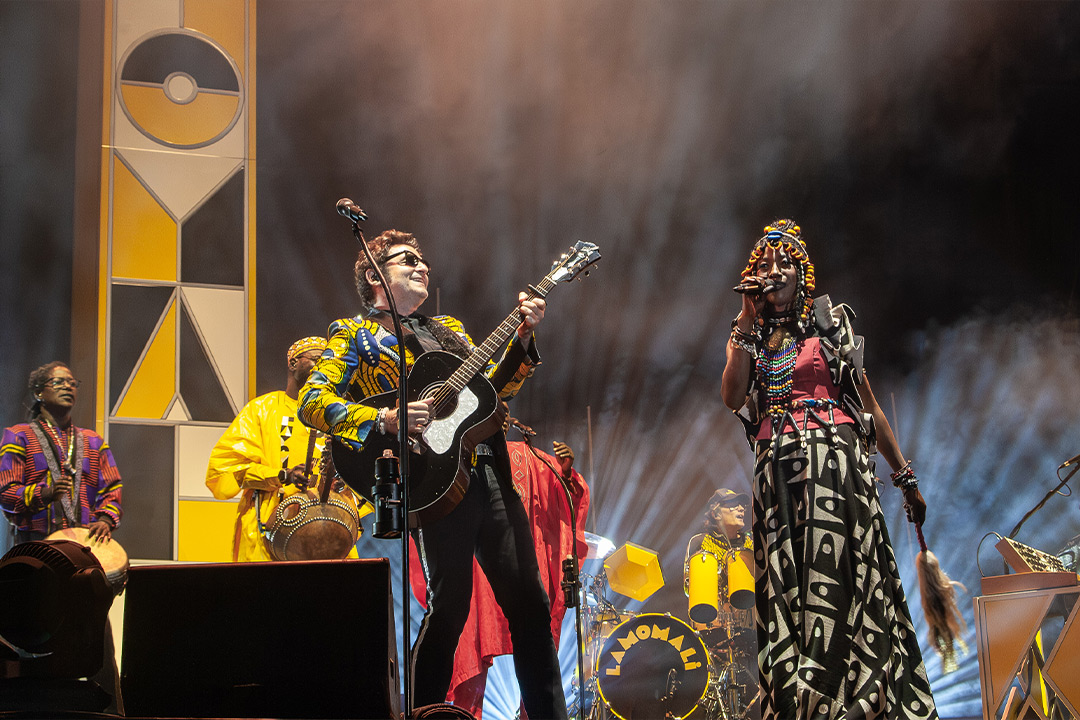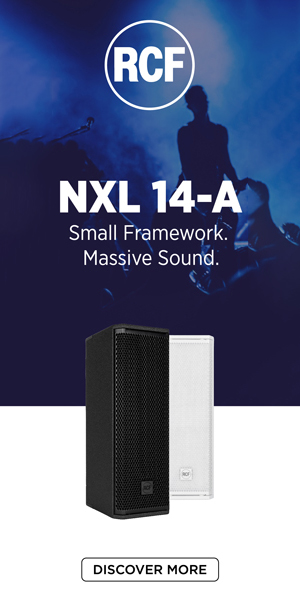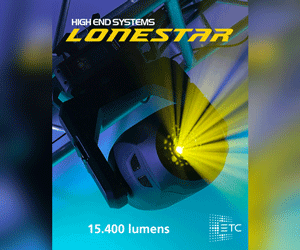With Spectera, Sennheiser has embarked on a complete revolution in terms of both the architecture and the operation of its first wireless system based on WMAS technology. Improved audio and RF performance, adjustable transmission quality and latency across a wide frequency range, new antenna management and new bidirectional pocket transmitters paired with a new one rack unit all combine to create a high-performance wireless system that fits into an ecosystem that is ready for future developments.
This has led to a fundamental rethinking of how wireless audio systems are approached. Since it went on the market in the spring of this year, we were eager to find out more about how it performs in the field. That’s why we met up with monitor engineer Nicolas D’Amato and wireless system tech Hugo Pacé, along with Charly Fourcade, Hadrien Soulimant and Ann Vermont of the French Sennheiser team, at Les Francofolies open air festival for an exceptional concert by Matthieu Chedid, featuring Lamomali. There, all of the in-ear monitors and several microphones were using Spectera.
While monitor world is being set up, the Sennheiser team welcomes us to their demo room, located in Théâtre de la Coursive, to show us the latest developments in the Spectera system.
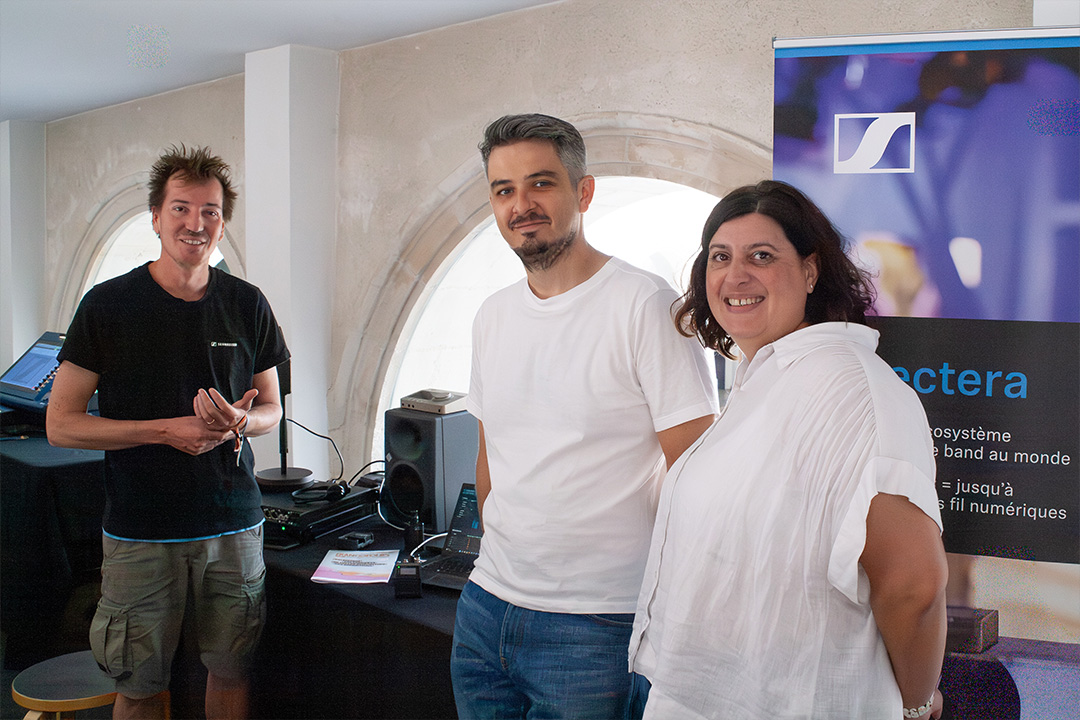
SLU : Is there a partnership between Sennheiser and Les Francofolies?
Hadrien Soulimant : We wanted to have a presence here and the production manager of the festival, David Prévost, opened the door to us. We wanted to give some meaning to our partnership, so we offered to sponsor the “Chantier des Franco” by providing the equipment for the venue that hosts emerging artists from January to May each year.
The artists develop their shows there, and some of them will then go on to make their stage debut at Les Francofolies. We are also involved in the tribute show to a French singer-songwriter, which opens the festival on the stage of the Théâtre La Coursive. As part of our three-year partnership, the festival has provided us with a room where we can welcome professionals attending the festival and show them our systems.
Our Spectera system is also being used on the main stage, with six rack units and two antennas. A Merging Technologies’ Anubis interface unit allows for analogue patching to the PFL of the monitor consoles used at the festival, so that any engineer who does not have MADI or Dante can still easily evaluate the system. Our equipment is always used with the approval of the technical staff, in a spirit of mutual understanding.
SLU : What’s new since our last Spectera presentation? (check out the article on SLU)
Charly Fourcade : Significant improvements have been made to the body pack’s resynchronisation time, which is now usually less than six seconds, compared to around ten seconds previously. The walk test can also be downloaded from the SoundBase website
SLU : Could it be said that Spectera system body packs work like smartphones?
Charly Fourcade : Yes, that’s a fair comparison. When switched on, the body pack searches for the channel it belongs on, much like when you turn off airplane mode on your mobile phone. For example, when the performer leaves the stage with their in-ear monitors on, their body pack might move out of range. When they return to the stage, it will resynchronise, even if the RF channel has changed frequency in the meantime.
SLU : And when will the handheld transceiver be available?
Charly Fourcade : It is currently in development. Initial results are promising. It will use the same batteries as the SEK transmitters (BA70 batteries) and will be compatible with all Sennheiser capsules that have a standard interface (G4/2000/EW-DX/D6000). It is scheduled to be shipping in 2026.
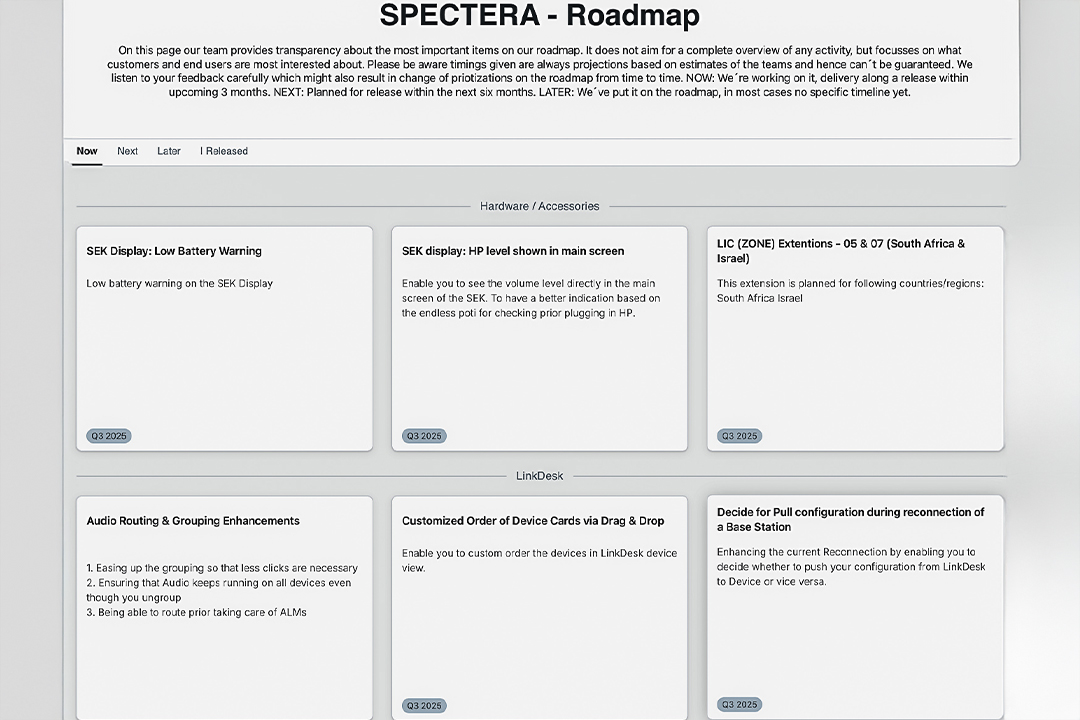
SLU : Spectera is a very open-ended system that will see many future developments?
Charly Fourcade :
The system is indeed left open to considerable evolution and upgrades. To decide on how to develop these, Sennheiser has set up several channels of dialogue with Spectera users. On the my.sennheiser.com website, a web page interface allows users to suggest, vote on or comment on new features, as well as see what is already planned and confirmed for the future (the Spectera Roadmap). There is also a Discord channel where the community can communicate directly with the Sennheiser team (further info at www.sennheiser.com/spectera-lab). For example, we can see that the “engineer” mode is expected in January next year, that the idea of a unit for eight additional antennas is being considered, etc.
SLU : Have volume limits for IEMs also been added?
Charly Fourcade : Yes. This allows you to set a volume range for the performer’s IEM. Regardless of what they do on their unit, the lower and upper volume limits will protect them from either excessive or insufficient levels. Of course, you can adjust this range remotely and control the volume within it.
SLU : Are there other ideas in development?
Charly Fourcade : Many others, like Engineer mode, which lets you listen from a pack to any audio signal from the ones on that RF channel. A pack set up like this would let you directly receive and convert audio from a source like a guitar or bass to analogue so you can plug it into a pedal board. There is also Push To Talk, the ability to name antennas, and the option to integrate Walk Test into Linkdesk, for example.
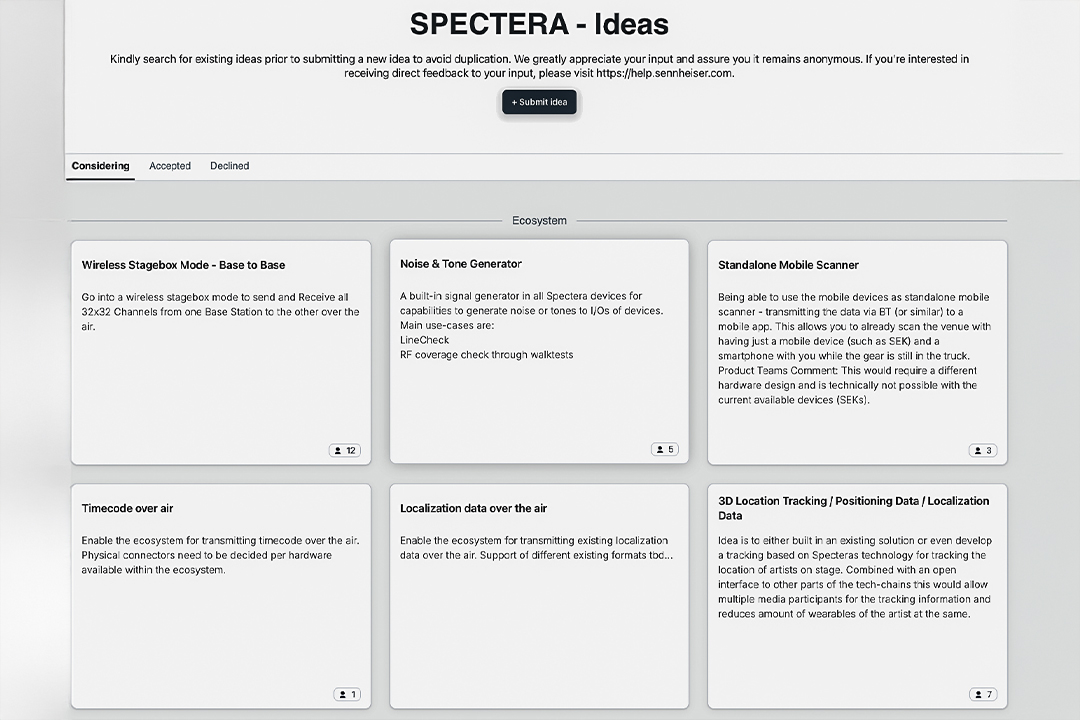
SLU : This clearly illustrates the high degree of scalability of the Spectera system…
Ann Vermont : Spectera’s features will in fact evolve, thanks to software development, which is a big change for a hardware manufacturer like us. We have been preparing for this for many years. With WMAS technology, we made the decision to start from scratch. It was an opportunity for innovation that we hadn’t seen in decades. Unlike traditional product development, two developers initiated this process and began their work in 2010 to create a truly scalable platform. They are still involved and receptive to feedback.
SLU : So, Spectera might be used for much more than wireless audio?
Charly Fourcade : I’m certain it will. It could incorporate features for creating talk-back pedals, or MIDI or OSC transmission. This already exists in the 2.4 GHz band, but it’s rather unstable. Spectera could safely transmit data on a frequency that is fully reserved, monitored and, above all, synchronised.
SSLU : What about tracking?
Charly Fourcade : In fact, with this system, which can manage four antennas in its basic version, users believe that there could be potential for further development in this regard… and, once again, development will depend on the number of requests.
SLU : Did Spectera handle any special requests for the Santa concert?
Charly Fourcade : Santa’s tour is already equipped with Spectera for the IEMs. For her show at Les Francofolies, the production team decided at the last minute to have the artist enter the stage via zip line from the Tour de la Chaîne, flying over the entire audience.
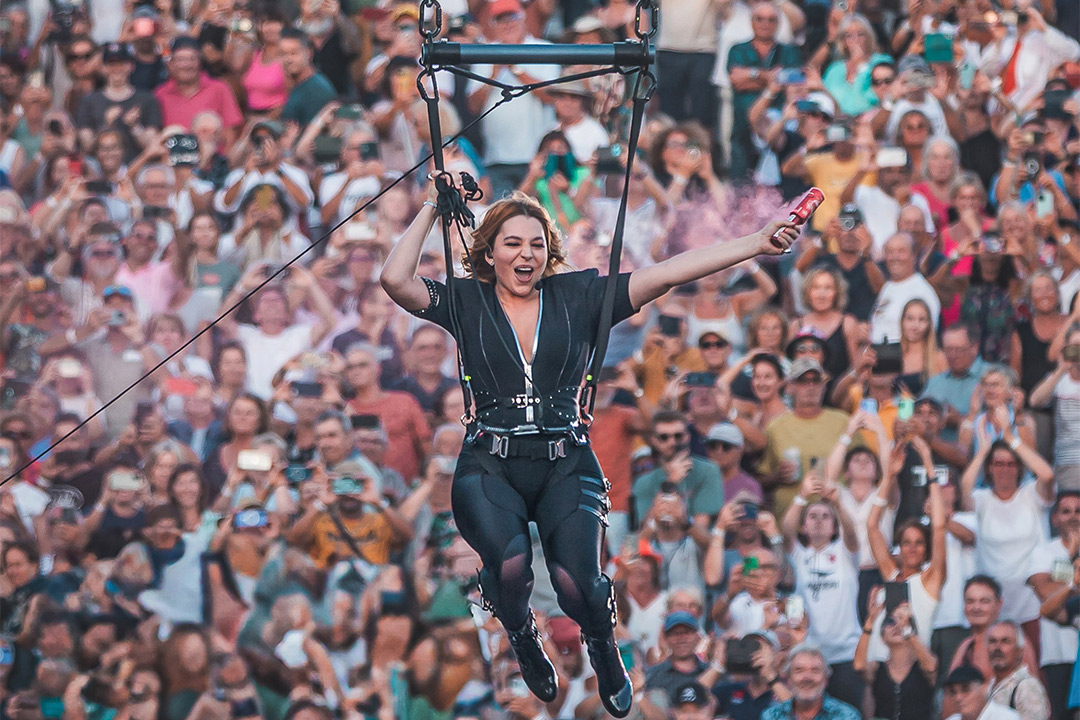
The RF tech then suggested using the Spectera body pack’s two-way capability for the IEM and her mic. An initial soundcheck with both antennas on stage proved to be a little unstable. The radio link was quickly made more secure by adding an antenna between the stage and the tower, on the display structure located along the large wall, connected to the Base Station by a simple Ethernet cable.
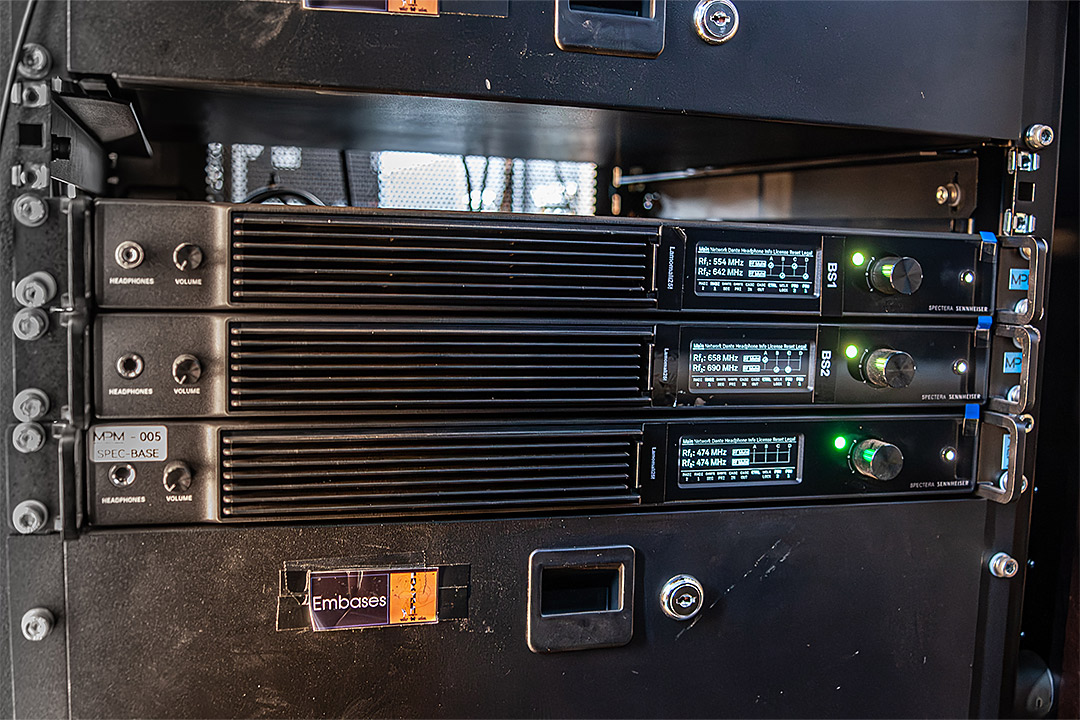
SLU : Is Spectera currently being used in contexts other than musical performances?
Ann Vermont : It’s currently in action for the July 14th celebrations at the Eiffel Tower in Paris. Next week, we’ll be heading to the Avignon Festival. After discovering the system last year, the technical team decided to entrust it with all the wireless links for the Cour d’honneur, a total of 32 microphones. To do this, they are using a single base station with 32 channels in its 8 MHz band. A front antenna and a remote antenna easily handle reception in all areas where the actors are performing.
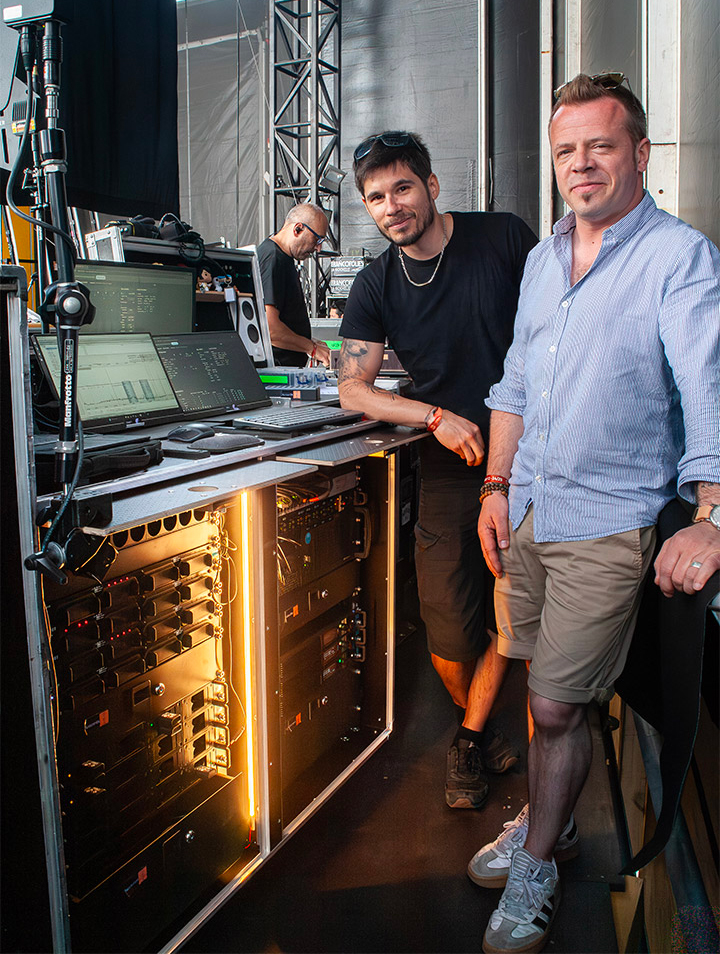
After this chat and a preview of the new features of the Spectera system, it’s time to head to the monitor control position of Nico d’Amato and Hugo Pacé, who are working on the Lamomali tour and whom we find here at the Francofolies for the closing concert.
SLU : Could you outline the Spectera system you’re using for Lamomali?
Nicolas D’Amato : We’re using two Base Stations and 42 SEK transceiver units, which we usually call packs. 32 of them are for all the in-ear monitors for the artists, musicians, guests, and technicians. The others are used for wireless microphone links, including a keyboard, Matthieu’s bass drum and the djembe, which has two links for the top and bottom.
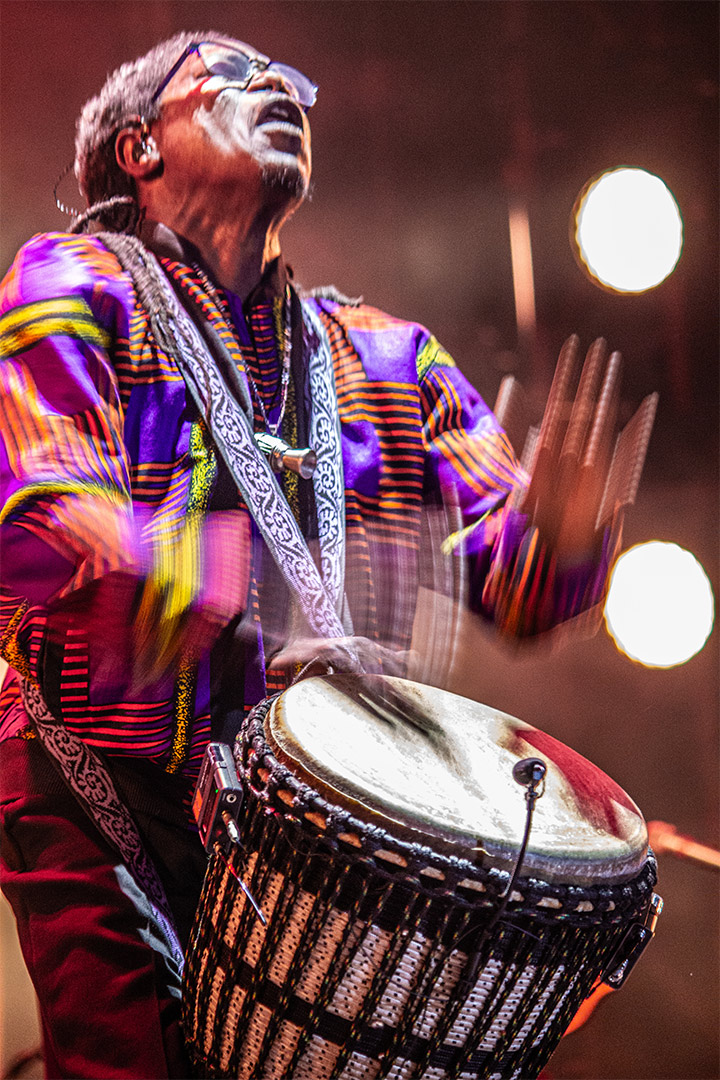
SLU : The sound of the djembé is particularly well balanced for two wireless mics…
Nicolas D’Amato : The djembé plays a rather important role in this show, as it’s often featured in very dynamic solos, so we put two Spectera packs equipped with Neumann MCM KK14 capsules on the top and bottom.
We get a very accurate, very realistic sound, without colouration and with truly stunning transients, especially in the low frequencies. The result is undoubtedly better with Spectera than with our previous wireless system.
SLU : And the other instruments using Spectera wireless links?
Nicolas D’Amato : Strangely enough, it’s mostly low-frequency percussion. Like Matthieu’s kick drum, a small yellow bass drum that comes into play on certain songs. We placed a pack inside with a Neumann MCM KK14 and an MC6 clamp, which we attached to a small homemade boom. The sound achieved with a miniature microphone and a wireless pack is simply astonishing for a bass drum. With Spectera, the transmission parameters of each pack can be adjusted independently according to the artists’ needs.
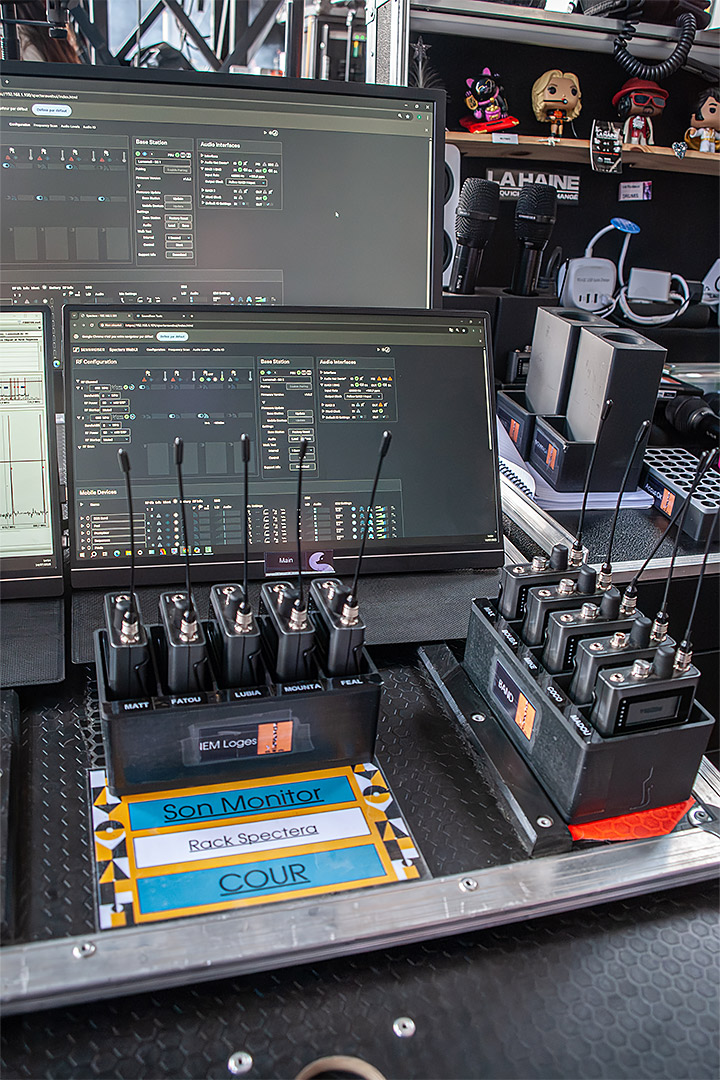
SLU : Are all the IEM channels configured the same way?
Nicolas D’Amato : Each quality parameter and transmission mode is managed completely independently. Appropriate settings can be assigned to each IEM link, including their transmission mode, depending on how they are used.
SLU : How do you control that in the system?
Hugo Pacé : The technical possibilities of our links depend on the resources that the Spectera system can provide. As we are fortunate enough to have two base stations in our setup, we have four useful 8 MHz broadband channels (two per base station – editor’s note) to handle all our transmissions.
We decided that the most important musicians would have the best possible audio quality in terms of bandwidth and latency – so, digital with 0.7 ms latency enabled by the Ultra Low Latency mode – and that the rest of the musicians and technicians would be in Low Latency mode, with slightly lower audio quality and 1.1 ms latency.
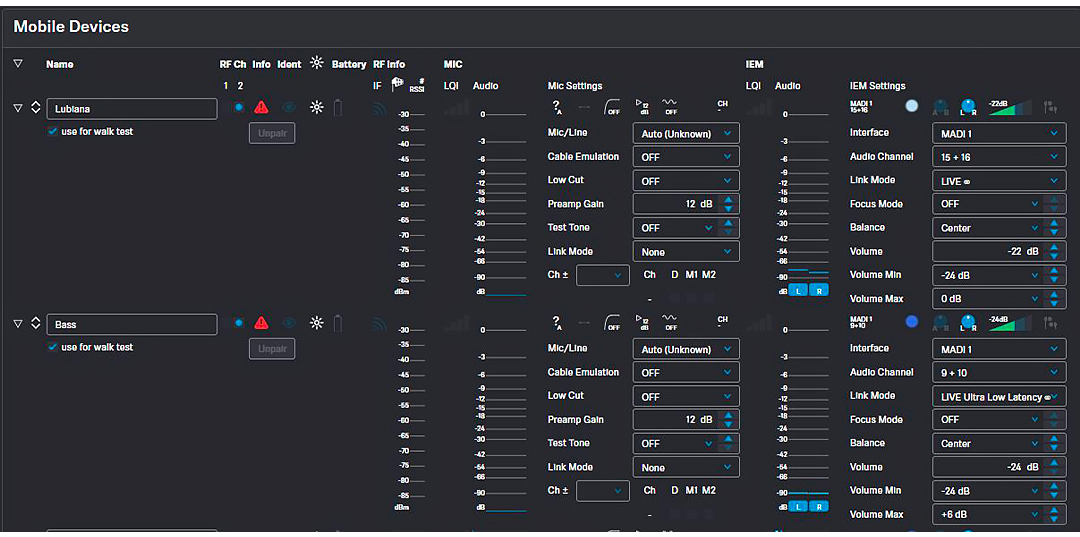
SLU : Was it not possible to put all the IEMs in the optimal mode?
Hugo Pacé : Doing so would have required a lot of resources. The latency of 1.1 ms is perfectly acceptable for the other musicians, and even more so for technicians. With this choice, we are using 100% of the first Base Station and 90% of the second. All this in just two rack units for 42 channels in impeccable digital quality. It’s truly unheard of!
SLU : Does the Spectera system also offer modes with even lower audio quality?
Hugo Pacé : Yes, which frees up resources to use for even more channels. But here, we’re able to handle all our needs with the highest quality. The result is impressive, with remarkable sound, no hiss whatsoever, and great respect for the sonic image.
Hadrien Soulimant : That’s the whole point of having an open system. For the moment, the various transmission modes provided meet the requirements. But if, in the future, we feel the need to create, for example, an even more powerful, very high-resolution PCM stereo mode occupying 8 MHz with a single stereo transmission, there is nothing in the system to prevent us from doing so. Perhaps in a year or two, depending on feedback, we will offer other modes.
Modes with higher latency, such as the 15 ms mode where you can put 128 microphones in 8 MHz, will be especially useful when we have handheld transceivers. If 90% of your bandwidth is used for “noble” links, these modes that take up very few resources would still allow you to easily add a dozen or so additional talk-back microphones.
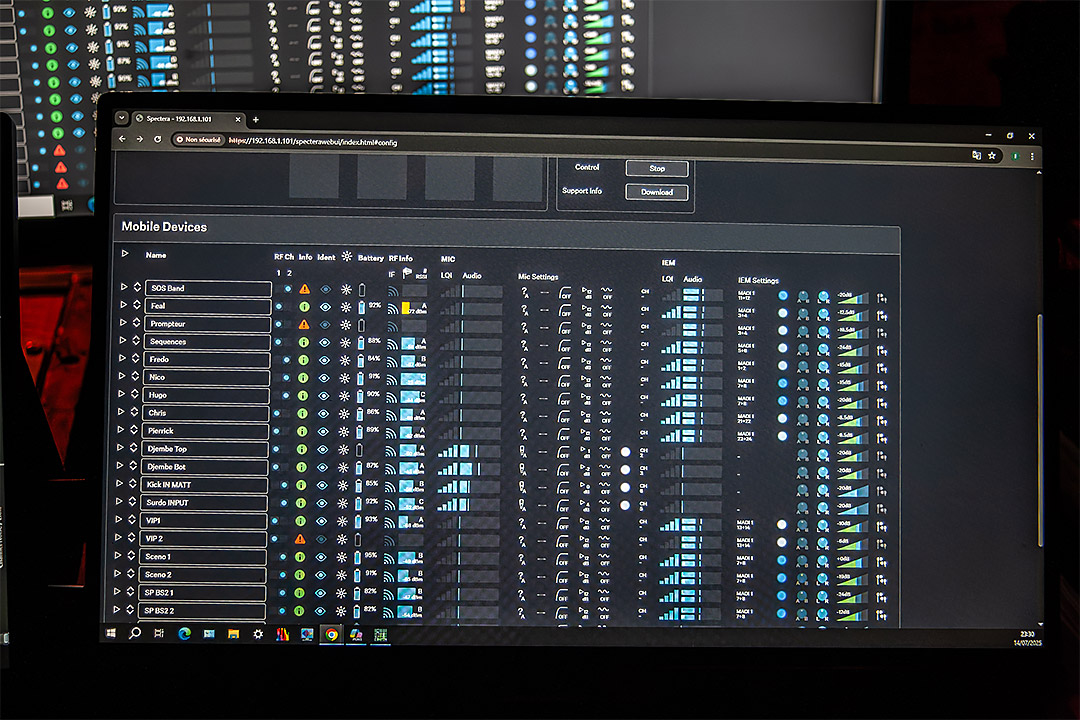
SLU : Do you need to be more careful when sending a signal of this quality to the musicians’ IEMs?
Nicolas D’Amato : I’ve never heard such a powerful body pack before. The built-in dual preamp is exceptional. I don’t think it’s possible to listen at maximum volume. There’s a lot of power in reserve, which requires a little more attention, especially since the volume control curve on the pack is linear. So much of the beginning of the volume knob’s range seems useless, and then suddenly there’s sound. The control is finely tuned in 0.5 dB increments and can get very loud.
We therefore set minimum and maximum level limits, which prove extremely useful. The unique feature of Spectera is that if you don’t send anything to the musician’s IEM, they hear absolutely nothing, not even background noise. They may then think that their level is too low and turn up the volume to an extremely high level without realising it. The maximum limit is therefore very important to prevent this type of mistake. The same applies to the minimum limit, which allows a minimum listening level to be maintained no matter what the musician does.
SLU : Is remote volume control also a considerable advantage?
Nicolas D’Amato : Musicians often need to listen louder than we do because they are in the middle of the action with the audience. What’s great is that we get feedback on the level at which they are listening, because we must never lose sight of the fact that this level changes the tonal balance and dynamic response, even if this is a little less obvious on Spectera. Whatever happens, it does not alter the Fletcher-Munson curve (which demonstrates the sensitivity of our ears, which varies with frequency, depending on the level applied – ed. Note).
So, if necessary, we can adjust the volume from our control position. It should be noted that we can also see the body pack’s LQI reception level, the battery level and whether the earpieces are properly connected. We have total control over the pack, and this is unique to Spectera.
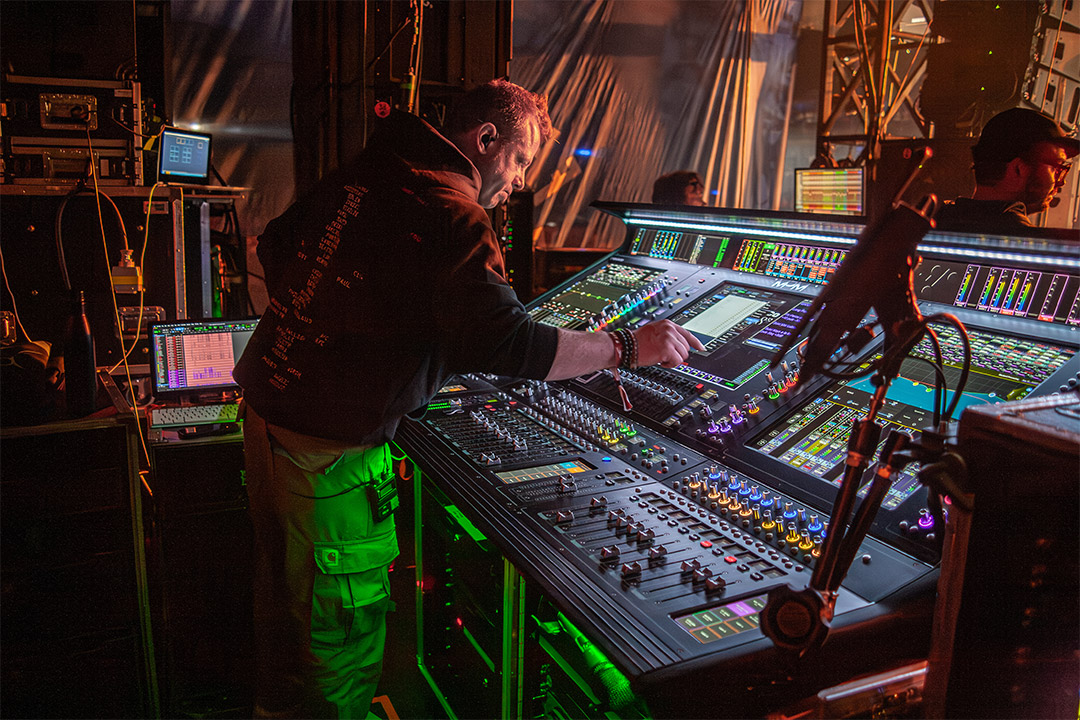
SLU : Does all this make your mixing job much easier?
Nicolas D’Amato : Oh yes. When I mix, I hardly compress anything so that the musicians can hear their dynamics. My output from the console is quite high, so I quickly reach a peak level that can touch the red. Even if I allow 20 dB of headroom at the start of rehearsals, this has decreased considerably by the time we get to the first concert.
In extreme cases where I am asked to turn up the volume, as can happen, I can no longer really do this on the console, and the only solution is to increase the gain on the IEM box and lower the rest. With Spectera, I don’t have to tell the musician to turn up his pack. I can do it remotely, either by turning up his volume or by freeing up a few dB on the maximum limit. It’s transparent and prevents us from saturating the IEM’s input stage.
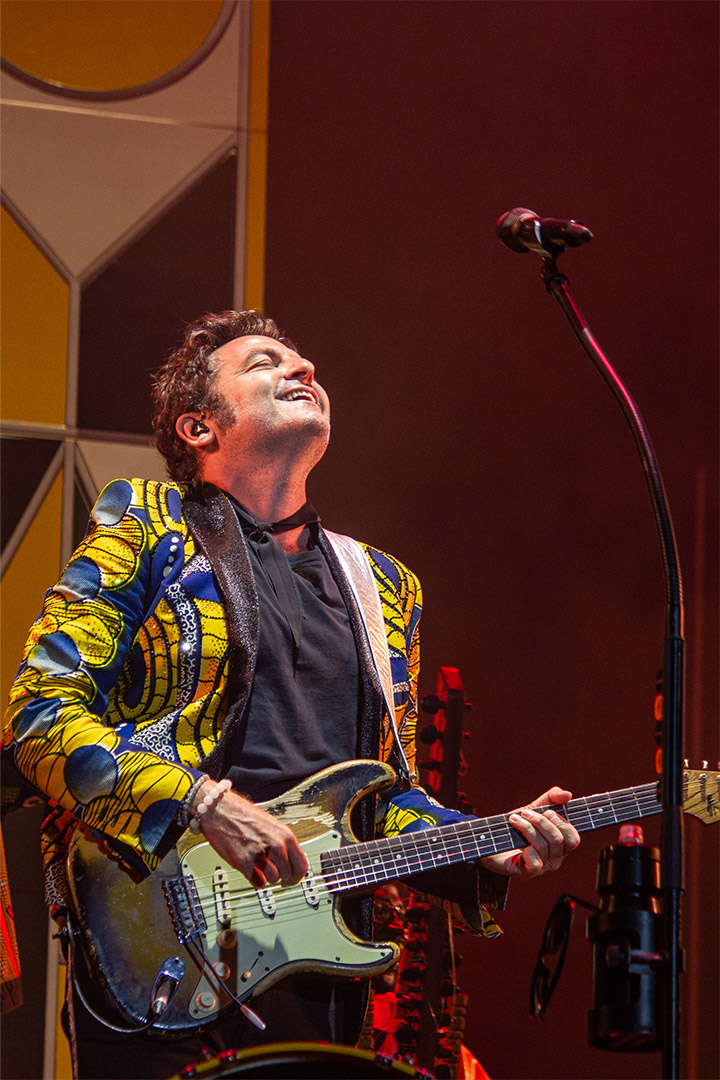
SLU : Have any musicians made any comments about the quality of the IEMs with Spectera?
Nicolas D’Amato : Absolutely. Everyone is really pleased. They appreciate the dynamics, the bandwidth, the total absence of noise and, above all, the precision of the details, as Matthieu Chedid pointed out. With this system, the mix can’t tolerate even the slightest error. They’re usually surprised by the stereo image, which is very wide, because I also mix the ambient sound in binaural. But they quickly get used to it, and when they go back to the old technology, they ask themselves what on earth we were doing.
SLU : Is the quality of the stereo image essential to your immersive approach to the ambient sound?
Nicolas D’Amato : The left/right separation is perfect and without any phasing issues. This brings the centre to the foreground, and this is essential for my way of mixing monitors, which involves mixing stereo music with binaural ambience.
The localisation of sources in the IEMs is particularly accurate for this use. I mainly send it to Matthieu’s ears, who needs it to hear the audience, and a little of it to the other musicians.
Immersive ambience is now always part of my setup. It’s essential, in my opinion. It adds the colour of the sound from the front of house, the audience, the ambience and, above all, the sound of the room with precision. It allows me to place a stereo music mix in a room with immersive binaural sound.
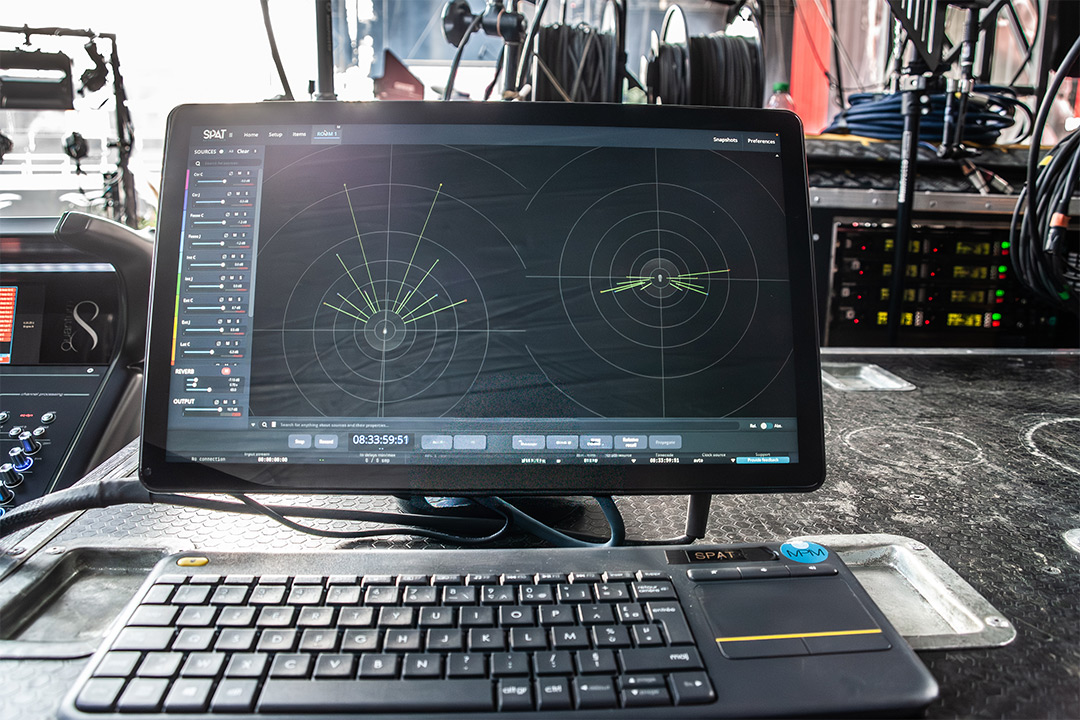
SLU : Doesn’t so much listening comfort interfere with the musician’s performance?
Nicolas D’Amato : I don’t think so; in fact, I would say that the opposite is true. The better the sound in their ears, the more they will enjoy playing. When we switched to Spectera, all the musicians clearly noticed the difference. That said, they are not necessarily focused on the sound quality of their monitors, and if they don’t think about it, it means that everything is fine.
SLU : Is it quicker to achieve to a satisfying mix for them?
Nicolas D’Amato : Since the mixes are more clearly defined, I have noticed far fewer requests from musicians. They can hear all the instruments distinctly, with precision across the entire spectrum and in their placement in the stereo field. It’s very musical.
SLU : Spectera is very promising for guitars, but that’s not been the case on this tour yet?
Nicolas D’Amato : In fact, this system wasn’t yet on the market when we started setting up the guitar rig for the tour. When I was able to get one of the first Spectera units fresh off the production line, there was no way I could ask the guitar tech to change his entire system. All the gain settings had already been configured between each guitar and its own effects on the pedalboard. With a very large guitar rig here, it would have been complicated to add a new element at that stage. But in any case, we will definitely consider integrating it on the next tour.
SLU : Does Spectera save you time during installation?
Hugo Pacé : When it comes to set-up and frequency management, the difference in time is so staggering that it’s hard to believe. Just not having to synchronise 42 body packs every morning saves us at least half an hour. All we have to do is find the available frequency space for our 8 MHz band. Once that’s done, our 42 packs are up and running in five minutes. We can’t wait for the handheld microphones to come out.
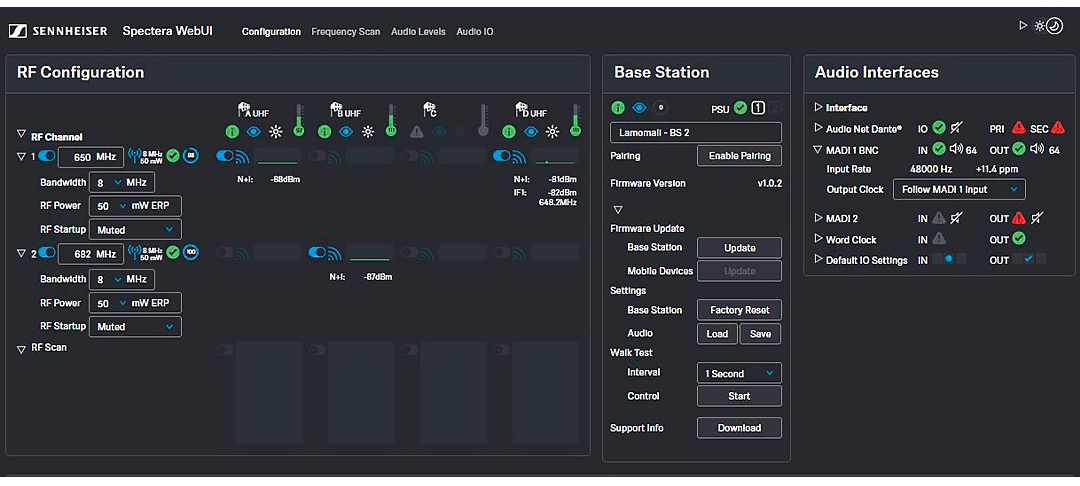
Nicolas D’Amato : I’m lucky to be working with Hugo, who has mastered the Spectera system and its software. He keeps a constant eye on the control screens and can intervene on any unit in a matter of seconds. This frees me up from having to worry about the RF side of things during the show.
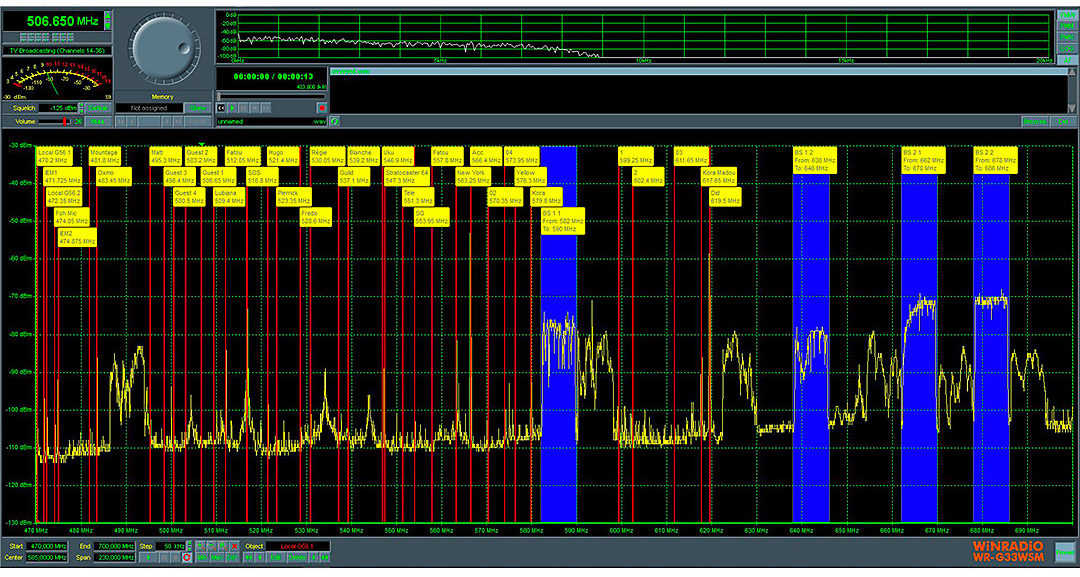
SLU : What happens if the 8 MHz band cannot be assigned without interference?
Hugo Pacé : It cannot be restricted within the machine. As less spectrum remains available, the system will perform less efficiently in terms of range, and the audio quality may need to be reduced. So far, we haven’t had any issues of this kind, even at festivals like this one, which are a bit more complex because several artists and stages are playing at the same time.
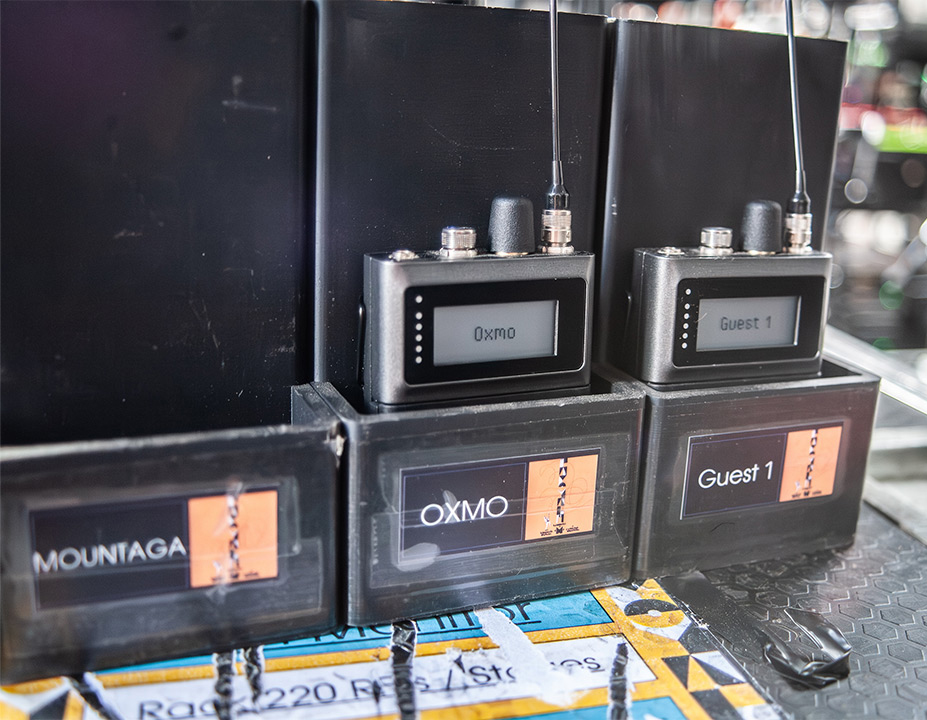
SLU : What about last-minute requests?
Hugo Pacé : It’s even more convenient. Once all the body packs are paired with the Base Station, I can decide in a second which mix goes into which pack and at what volume. Another important detail for the musicians’ comfort is that when the pack is reactivated, it maintains the volume it had when it was turned off.
This is another advantage of the Spectera system. On the morning of each gig, I switch on all the packs, and the listening levels are immediately ready to go. The musicians don’t have to think twice when they put their in-ear monitors back in; they hear what they’re used to hearing. That’s one less thing to worry about.
SLU : Is the breakthrough for Spectera also offering two-way body packs?
Nicolas D’Amato : That’s a real revolution. We used one to handle the use of a vocoder. So this single body pack handled both the send input (via IEM from the Base Station) and the microphone output return for the vocoder. It worked perfectly. This application didn’t make it into the final show, but having a single body pack for both functions is a huge convenience for the wireless engineer and the musician. From the moment an artist decides to use a headset microphone, this really is the ideal solution. However, I think this application is more suited to musical theatre than this type of concert format.
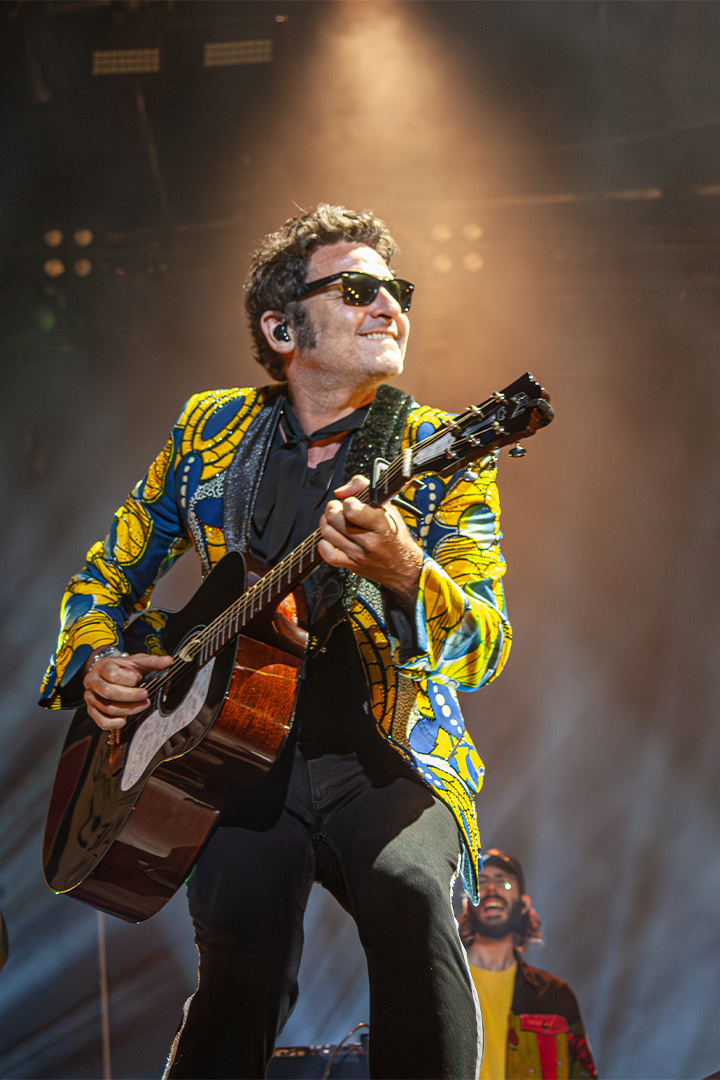
SLU : And would that be feasible for guitarists?
Nicolas D’Amato : The problem for guitarists is that they often change instruments. Having your IEM and guitar transmitter on the same two-way body pack is impossible to manage, unless you only use one guitar, which is rarely the case, especially since you must consider the possibility of a broken string. The right solution for them is to have one pack for their ears and one pack per guitar.
On the other hand, we could very well consider using a Base Station dedicated solely to his guitars. Since it outputs Dante and MADI, we would need to add a high-quality analogue conversion solution so that his guitars enter his pedalboard at the right level and with the right impedance to maintain consistent gain staging. We would then be in digital mode with very low latency, equivalent in quality to wired.
I think guitarists will appreciate this. Bassists will too, because with RF, they often lose a significant part of their signal in the low frequencies and suffer from the effects of analogue companders. Spectera should eliminate all these problems.
SLU : How are your base stations connected to the console?
Nicolas D’Amato : Two MADI signals are output from the monitor console to feed the IEMs via the two Base Stations. For the eight wireless microphones managed by Spectera, a MADI signal is output from one of the two Base Stations and then split between the FoH and monitor consoles using a MADI bridge.
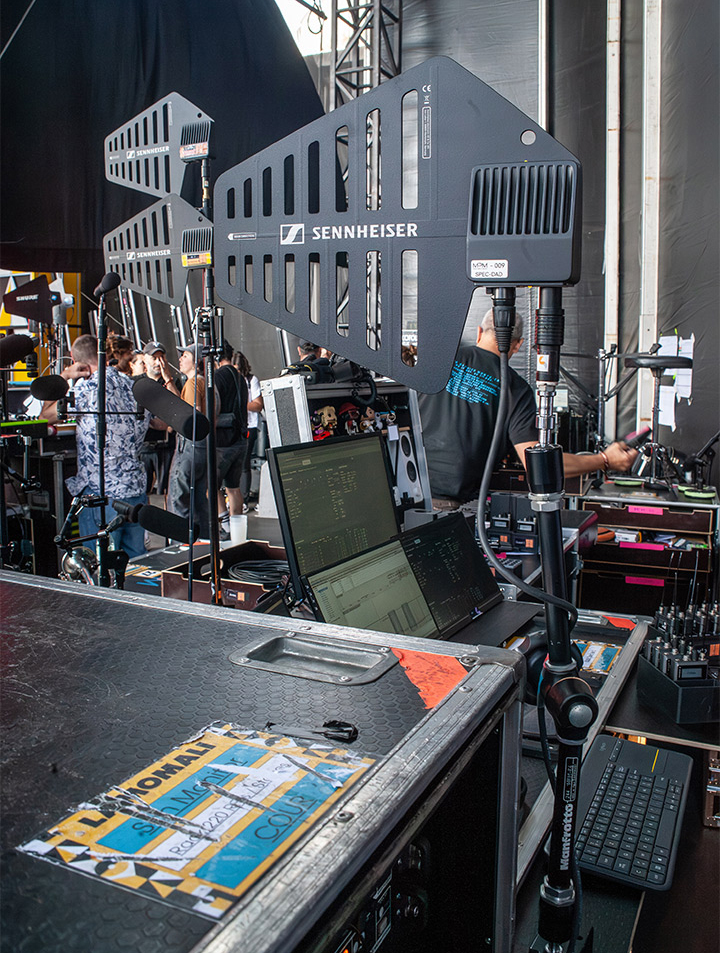
SLU : And, of course, an important point: how have antennas evolved with Spectera?
Nicolas D’Amato : To be honest, it’s pretty long range. We have six antennas. Two for the stage and two for the control room, and since we have a singer/guitarist who likes to go out into the audience, we added two more antennas facing the audience. The connection is RJ45, which allows us to place them up to 100 metres away from the base station if necessary. Here, they are all on stage.
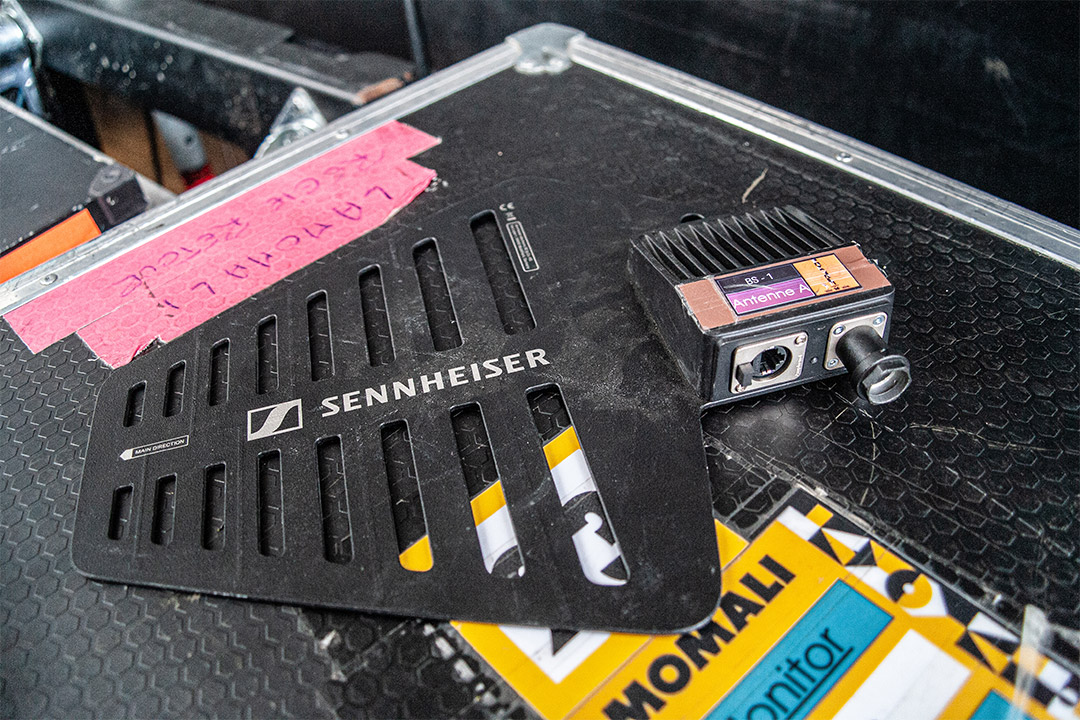
If we need to go even further, we will simply switch to fibre for distances of up to 4 km with the appropriate converters. That is what we will be doing in the autumn on the tour in arenas. We will install two additional antennas at FoH. Each base station can manage four antennas, which can be combined as desired: four antennas on one RF channel, two antennas on two channels, or one antenna per channel, for both transmission and reception.
Hugo Pacé : The antenna management is extremely flexible, making it easy to adapt the system to different situations. At a festival, we were playing last and our mix position was very far from the stage antennas. We simply and easily added an antenna at the FoH position to ensure reception. The antennas are also very directional, allowing us to quickly resolve issues that can’t be predicted by scanning tools.
SLU : Have you had any dropouts or other transmission issues?
Nicolas D’Amato : We haven’t been immune to RF dropouts during our coverage searches with Spectera. The only real test is a concert, because an artist in the middle of the audience surrounded by people pressing in close to them is not something that can be replicated in rehearsals. Last night, we had an audio dropout when the audience crowded around him. The RF and data connection was still working. We just lost the audio. The reconnection happened quickly, but not as quickly as with a traditional analogue IEM, which is worth noting.
Another time, we were very close to a lighting truss, with fixtures emitting a particular type of radiation that was likely to interfere with our transmissions. Moving the antennas further away solved the problem, but we are faced with unknowns that the reality of live shows highlights every day.
With this WMAS system, we are discovering new types of signal interference, such as unexpected saturation or very short dropouts. We quickly solved the problem by installing an additional antenna and also by changing the transmission mode quality. Apart from that, we have used the system for more than 15 dates, and it seems to be shaping up as a concrete tool for the future.
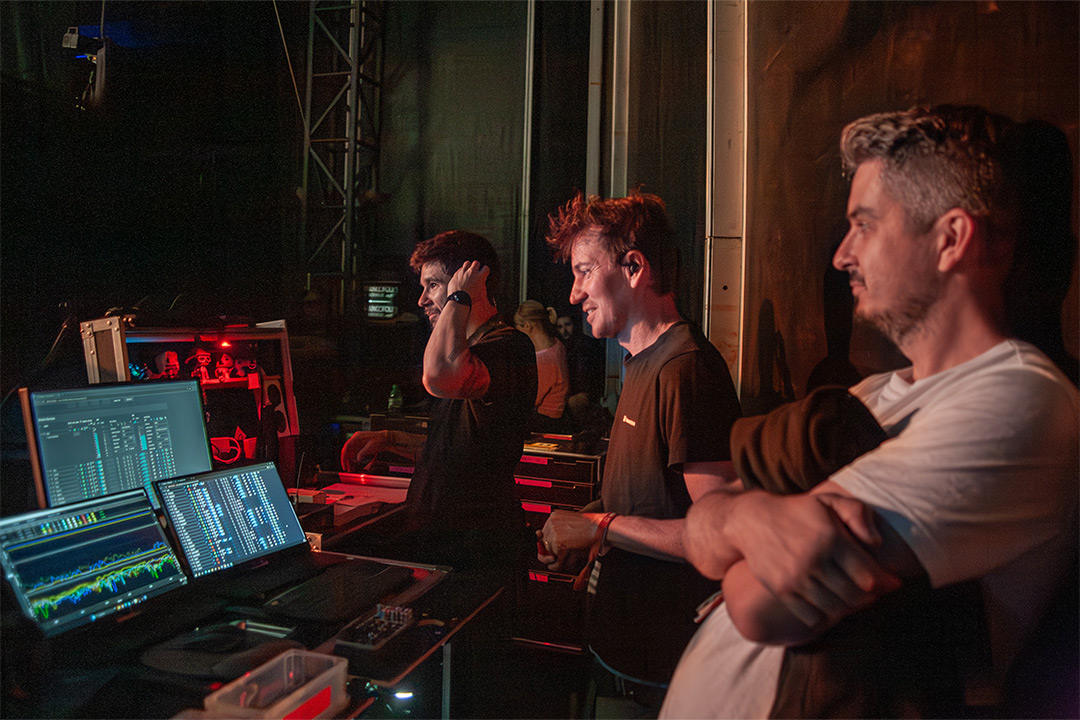
SLU : Does this new antenna technology help save time during installation?
Hugo Pacé : Before Spectera, I had to take all the IEM packs and walk around the stage to check that everything was working without noise or distortion. With Spectera, I save almost two hours of work, which is very useful at festivals where we only have time to check during set changes. We obviously listen to the whole system again for security, but classic analogue dropouts due to masking effects and other interference have disappeared from the landscape.
SLU : What about the ease of use in operation?
Hugo Pacé : With our two Base Stations, we only use four 8 MHz bands, with a steep filter at each end of the band, and that’s it. This allows us to completely avoid the intermodulation problems that increase with the number of narrowband transmission channels used. We really are saving spectrum. The first RF coordinators we met at festivals were a little scared by our four 8 MHz channels; they thought it was enormous. We explained to them that there was no intermodulation. They quickly understood that it was much simpler and there were no nasty surprises.
SLU : Is it always easy to find space for your four 8 MHz bands?
Hugo Pacé : In reality, a Spectera band takes up the same space as a digital terrestrial TV channel. It’s simple to manage, even in border areas such as Nice in France or Belgium, which have DTT channels from several countries. So far, we’ve always been able to fit in our four channels.
SLU : So Spectera pollutes the spectrum much less than we might have thought?
Hugo Pacé : The transmitter’s output power is 50 mW, spread across the entire 8 MHz band. If, unfortunately, you transmit on a colleague’s channel, their narrowband receivers, which only monitor 200 kHz, will detect interference of less than 2 mW. We therefore cause much less pollution in the spectral environment.
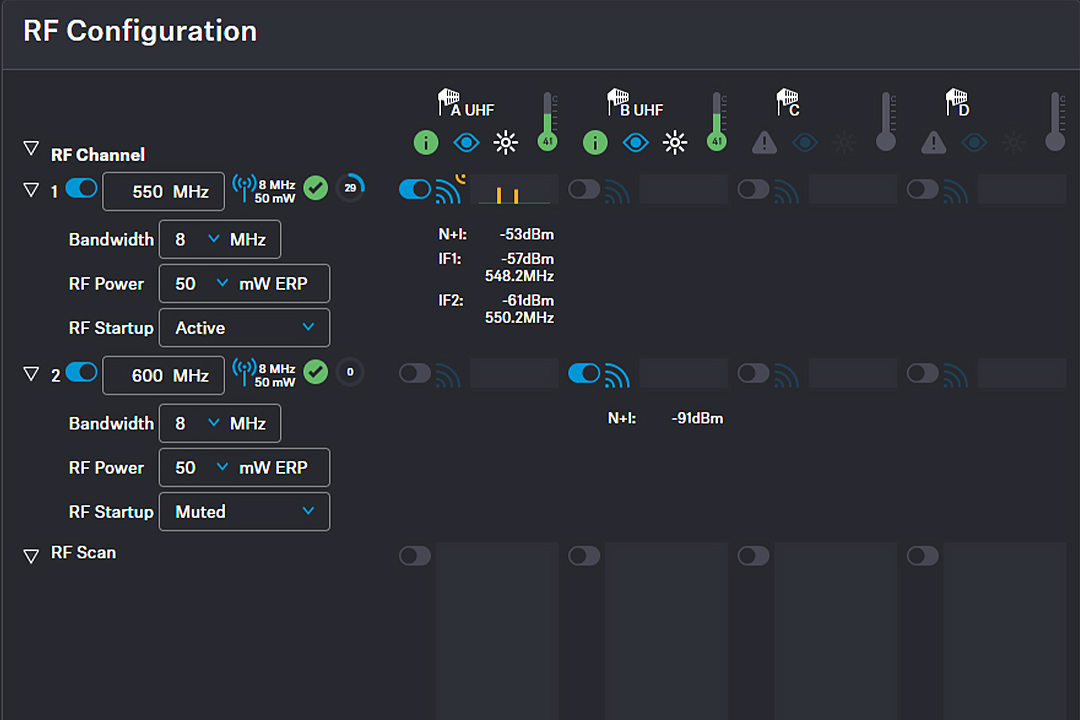
SLU : Does the Spectera system incorporate RF rejection filters?
Hugo Pacé : If a disruptive frequency appears in the band, these filters activate to reject it. We can visualise their activity. It allows us to maintain the same transmission quality even if unexpected events occur on the spectrum, such as a technician changing the batteries in a transmitter without turning it off first.
Since I can visualise the frequency of these filters, I can activate them in WinRadio and listen to what it is, as long as it’s analogue. And then, armed with a good peashooter, I hunt down the culprit. ;0)
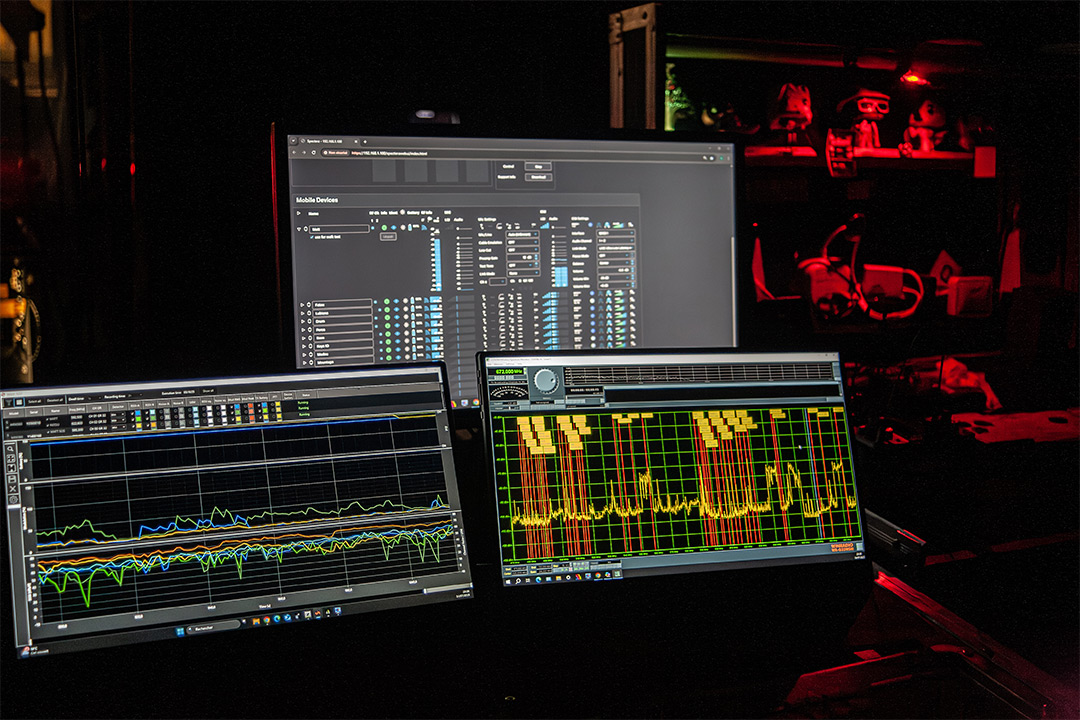
SLU : What about the battery life?
Nicolas D’Amato : The batteries last a very long time, and we receive and monitor charging data, which is also new to us and is, above all, crucial and unprecedented information. This obviously gives us lots of ideas for software development in terms of the information we can transmit and the many possible uses of the system.
SLU : Do you work without redundancy?
Nicolas D’Amato : Redundancy isn’t available yet. I have confidence in the system because I’ve tested it, and we haven’t had any audio synchronisation issues so far. We have a third backup base station just in case, because we don’t have much real-world experience with it yet. But the system has been rock-solid so far. That’s another reason why we chose it.
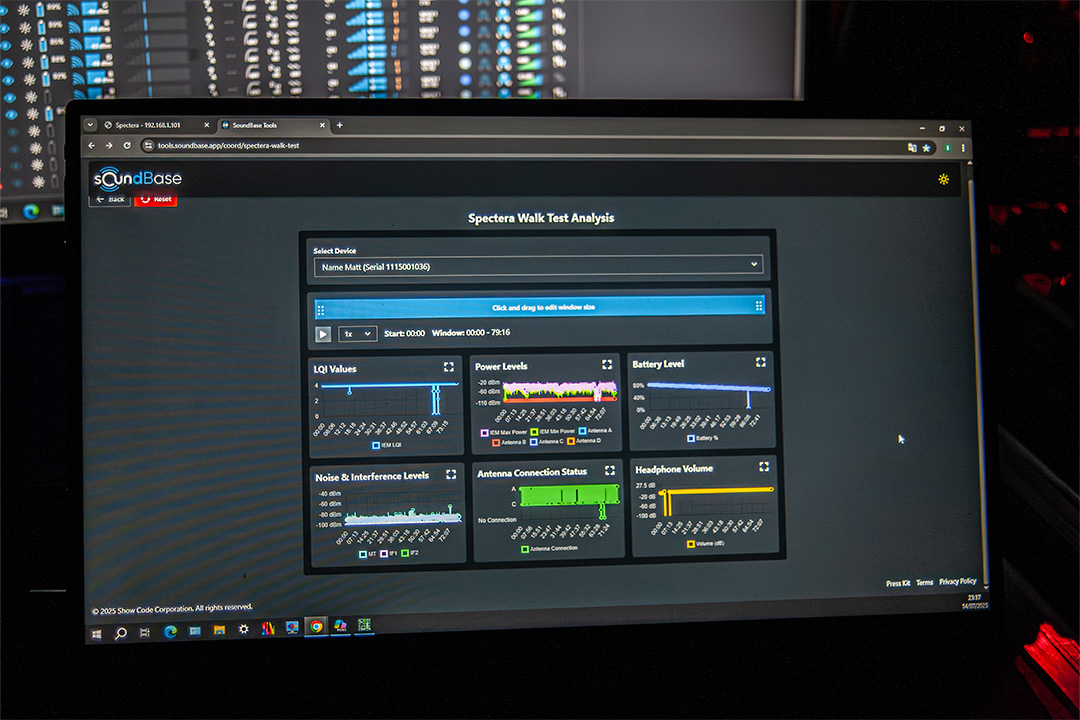
SLU : Is it possible to save the log files?
Hugo Pacé : Spectera’s software can record all the information about the body packs during the show – reception levels, batteries, etc. – for each antenna. This allows us to review the data after the show and, if there is a problem, understand where it came from.
I use it a lot for the moments when Matthieu goes into the audience, to find out where he lost the signal, why and how. This tool does not operate continuously. The operator must activate it.
SLU : Do you use the Soundbase software?
Hugo Pacé : I’ve been using it for Spectera’s Walk Tests. I haven’t really explored the software beyond that. I’m currently working with EazyRF, and during festivals, I haven’t had time to figure out how to work with SoundBase. This software seems powerful and opens up new possibilities. Its multi-brand capability is obviously its strong point, and it also gives you a way to communicate with the system’s development team.
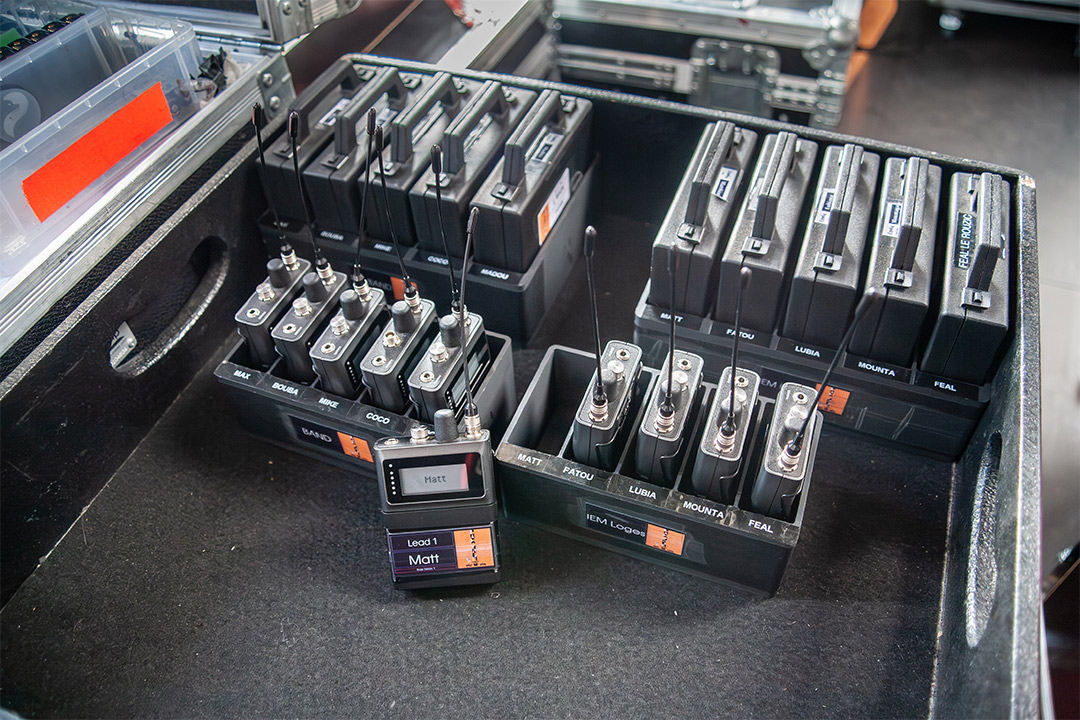
SLU : Does this new level of audio quality influence your choice of monitor earphones?
Nicolas D’Amato : As far as we’re concerned, not for the moment. The Earsonics that I’m using are well suited, even if, in absolute terms, new technological developments and other advances would be beneficial to everyone. Perhaps there are other, more effective solutions available from American manufacturers, but here, it’s important to have a French earphone manufacturer nearby that can handle maintenance quickly and that is one of the best in the business.
SLU : Finally, are you satisfied?
Nicolas D’Amato : So far, everyone has been. Since the system is new and it’s festival season, we’ve met lots of curious people who wanted to listen to it. We always prepare some extra packs for this purpose. It’s quite nice to be able to talk to everyone and hear their opinions on this system, regardless of their background. Overall, people are quite impressed by the new paradigm from Sennheiser, even the most demanding musicians. I believe that’s also your experience…
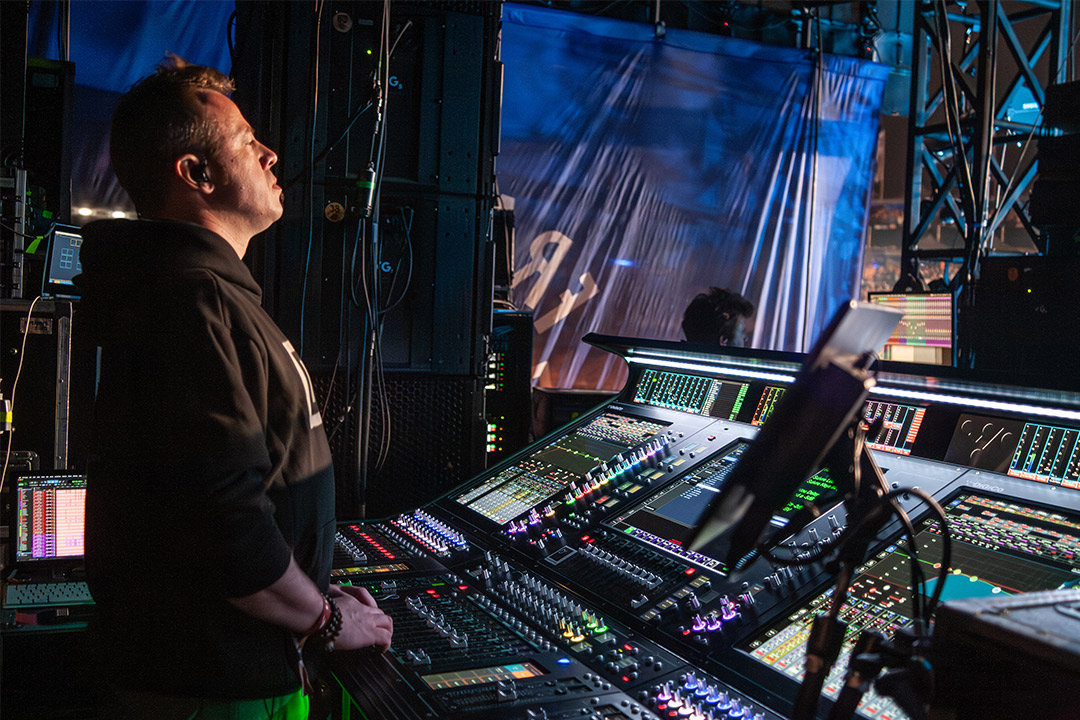
With Spectera, everything really is new. You must start from scratch. Forget compatibility with old systems. Forget the old ways of working. Learn new software, tackle new challenges, develop new reflexes.
Has Sennheiser’s bold decision to reinvent wireless audio been widely welcomed? It would appear so. The first steps with Spectera in operation are easy and more than encouraging. There are important moments in technical evolution that should not be missed. Nicolas d’Amato seems to be very aware of this and does not regret being among the first to embrace this new vision of wireless audio in his monitoring kit.
More information with:



